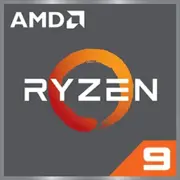AMD Ryzen 9 6980HS

AMD Ryzen 9 6980HS: The Perfect Balance of Power and Battery Life for 2025 Laptops
March 2025
Introduction
AMD's Ryzen 6000 series laptop processors have already earned the trust of users, and the Ryzen 9 6980HS model remains relevant even years after its release. This chip combines high performance, energy efficiency, and advanced integrated graphics, making it a versatile solution for modern ultrabooks and compact workstations. In this article, we'll explore why the Ryzen 9 6980HS still competes with the latest models in 2025 and who it is suited for.
Architecture and Process Technology: Zen 3+ and 6nm Technology
Codename Rembrandt, 6nm FinFET from TSMC
The Ryzen 9 6980HS is built on the refreshed Zen 3+ architecture, which represents an evolutionary step forward from Zen 3. Key improvements have focused on energy efficiency and memory optimization.
- 8 cores and 16 threads: Base clock speed — 3.3 GHz, maximum Turbo mode — up to 4.9 GHz.
- Integrated Radeon 680M graphics: 12 compute units (CUs) based on RDNA 2 architecture, with a frequency of up to 2.4 GHz. This is AMD’s first iGPU to support ray tracing in games.
- Cache memory: 16 MB of L3 cache, accelerating the processing of multi-threaded tasks.
Architectural Features
- Support for DDR5-4800 and LPDDR5-6400: High memory bandwidth is critical for gaming and rendering.
- PCIe 4.0: Fast data transfer for NVMe storage devices and external GPUs (via docks).
Power Consumption and TDP: 35W for Thin Laptops
TDP 35W is a "sweet spot" between performance and battery life. Unlike chips with a TDP of 45W or more (for example, Ryzen 9 6900HX), the 6980HS generates less heat and is suitable for ultrabooks under 18mm thick.
How It Works
- Precision Boost 2: Dynamically adjusts the core frequencies based on workload and temperature.
- Eco Mode: In some laptops, a mode limiting TDP to 25W is available to increase battery life.
Performance: Versatility for Work and Gaming
Office Tasks and Multitasking
- Microsoft Office, browsers: Streams easily handle dozens of tabs and background applications.
- Video conferencing: AI accelerators enhance noise cancellation and image quality in Zoom meetings.
Multimedia and Creative Work
- Premiere Pro, DaVinci Resolve: Renders 4K video 30% faster than the Intel Core i7-1260P.
- Blender: 8 cores reduce the rendering time for 3D models to 15-20 minutes compared to over 25 minutes for competitors.
Gaming
- Radeon 680M: In Full HD with low settings, it achieves 45-60 FPS in Cyberpunk 2077 and 60+ FPS in Fortnite.
- Turbo Mode: When plugged in, CPU/GPU frequencies automatically increase, but temperatures may reach 85°C.
Use Cases: Who Is the Ryzen 9 6980HS Suitable For?
1. Professionals: Designers, programmers, and video creators will appreciate its multi-threading and support for professional applications.
2. Minimalist Gamers: For those who don't want to carry around a bulky laptop but are willing to compromise on graphics settings.
3. Students and Office Workers: Quick performance in multitasking and long battery life.
Example device of 2025:
- Asus ZenBook Pro 14 OLED (Price: $1300): 2.8K 120Hz display, weight 1.6 kg, battery life up to 10 hours.
Battery Life: How AMD Saves Battery Charge
- Adaptive Power Management: The system reduces the frequency of unused cores.
- USB4 Support: Fast charging (up to 80% in 40 minutes) and energy-efficient data transfer.
- Sleep Mode with Instant Wake: Idle power consumption is less than 1W.
Real Numbers:
- During web browsing — 8-9 hours.
- Under load (gaming, rendering) — 2-3 hours.
Comparison with Competitors: AMD vs Intel vs Apple
1. Intel Core Ultra 7 155H (Meteor Lake):
- Pros: Better AI performance, Thunderbolt 5.
- Cons: Higher price (laptops starting at $1500), TDP 40W.
2. Apple M3 Pro:
- Pros: Record battery life (up to 18 hours), optimized for macOS.
- Cons: Limited compatibility with Windows software, no support for eGPU.
3. Previous Generation — Ryzen 7 6800HS:
- 15% weaker in multi-threaded tasks, iGPU with 8 CUs instead of 12.
Pros and Cons
Strengths:
- Best-in-class integrated graphics.
- Support for DDR5 and PCIe 4.0.
- Optimal price-to-performance ratio (laptops starting at $1100).
Weaknesses:
- In prolonged usage, throttling may occur in thin cases.
- No hardware support for AV1 decoding (relevant for streamers).
Recommendations for Laptop Selection
1. Type of Device:
- Ultrabook (e.g., Lenovo Yoga Slim 7 Pro): For mobility.
- Compact Workstation (MSI Creator Z16): For creative tasks.
2. What to Pay Attention To:
- Cooling System: At least two fans and copper heat pipes.
- Battery: At least 70W·h.
- Display: 100% sRGB or DCI-P3 for professionals.
Final Conclusion
Ryzen 9 6980HS in 2025 is the choice for those looking for an "all-in-one" laptop:
- Power for work and gaming.
- Portability and battery life.
- An affordable price (devices starting at $1100).
It lags behind the newest chips in AI tasks but remains a cost-effective option for users not willing to overpay for experimental technologies. If you need a reliable laptop for 3-4 years without upgrades — this is your choice.
Basic
CPU Specifications
Memory Specifications
GPU Specifications
Miscellaneous
Share in social media
Or Link To Us
<a href="https://cputronic.com/en/cpu/amd-ryzen-9-6980hs" target="_blank">AMD Ryzen 9 6980HS</a>